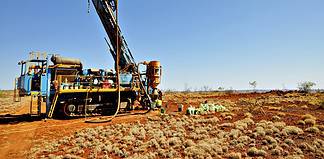The Australian Government today launched its 2022 Critical Minerals Strategy today as part of a package of measures to develop the sector, while the nation’s resources and energy exports is expected to reach a record high of $379b this financial year.
The updated Strategy builds upon the first one published in 2019, which aims to put Australia at the centre of meeting the growing demand for critical minerals by 2030, and is part of the 2022-23 Federal Budget.
Prime Minister Scott Morrison said Australia’s resources companies were leading the world in developing new critical minerals markets.
“As the global economy changes, there are exciting new growth opportunities emerging in areas such as rare earths and critical minerals that ultimately mean we can deliver a stronger economy for Australia and secure a stronger future,” he said.
Two new minerals were added to Australia’s critical minerals list – high purity alumina and silicon – while the $2b Critical Minerals Facility, established in 2021, issued its first two loans last month to EcoGraf Limited for its Australian Battery Anode Material Facility in WA and Renascor Resources for the development of its integrated graphite mine and processing facility in South Australia.
Australia currently produces around half the world’s lithium and is the second largest producer of cobalt and the fourth largest rare earths producer.
Federal Resources and Water Minister Keith Pitt says today’s updated Strategy launch aims to grow the nation’s critical minerals sector, expand downstream processing and help meet future global demand.
“The Strategy will cement Australia’s position as a leading producer of critical minerals, while contributing to our national security and economic prosperity,” he said.
“Developing and diversifying our resources sector strengthens our national economy, delivering jobs and growth opportunities, especially in regional Australia.”
Minister Pitt said Australia’s large critical minerals reserves, the nation’s technical expertise and track record as a reliable and responsible supplier, enable the sector to respond to increasing global market demand.
“We can also expand into downstream processing and embed Australia in global supply for technology ranging from mobile phones to fighter jets,” he said.
Other measures announced include a $200m Accelerator grants program and $50m to support research and development.
The Accelerator program aims to support strategically significant critical minerals projects at the early to mid-stage in order to fast-track them to the market.
“By backing these important projects, we are also driving private sector investment to enhance Australia’s strong international reputation as a reliable supplier of the resources the world needs,” Minister Pitt said.
A total of $50m over three years will be committed to establishing the virtual National Critical Minerals Research and Development Centre, which will draw together the expertise from CSIRO, Geoscience Australia and the Australian Nuclear Science and Technology Organisation.
“This Centre will build Australian capability in critical minerals processing, target technical bottlenecks in strategic supply chains, and drive breakthrough collaborative research,” Minister Pitt said.
“The Centre’s projects will help unlock new sources of economically viable critical minerals, and diversify supply chains of strategic interest to Australia and our allies.”
In other news, the Australian Government also announced over $243m in support for four projects under the Modern Manufacturing Initiative that will create 3400 jobs in the rapidly growing critical minerals, electric vehicle and battery markets.
- $119.6m for Pure Battery Technologies’ $399m WA pCAM Hub, in partnership with Poseidon Nickel, will build an integrated nickel manganese cobalt battery material refinery hub in the Kalgoorlie region.
- $49m for a $367m project led by Australian Vanadium to process high-grade vanadium from its Meekatharra mine in WA and transported to its Tenindewa plant powered by clean hydrogen from partner ATCO Australia.
- $30m for Arafura Resources’ flagship Nolans project near Aileron in Central Australia, the first of its kind rare earth separation plant in Australia and only the second outside China.
- $45m for Alpha HPA’s $330m project with Orica to construct a high purity alumina production facility near Gladstone that will help meet the rapidly expanding demand for lithium-ion battery and LED lights.
Federal Industry, Energy and Emissions Reduction Minister Angus Taylor says these projects will help Australia capture a bigger share of the global supply chain.
“China currently dominates around 70-80% of global critical minerals production and continues to consolidate its hold over these supply chains,” he said.
“This initiative is designed to address that dominance.”








































